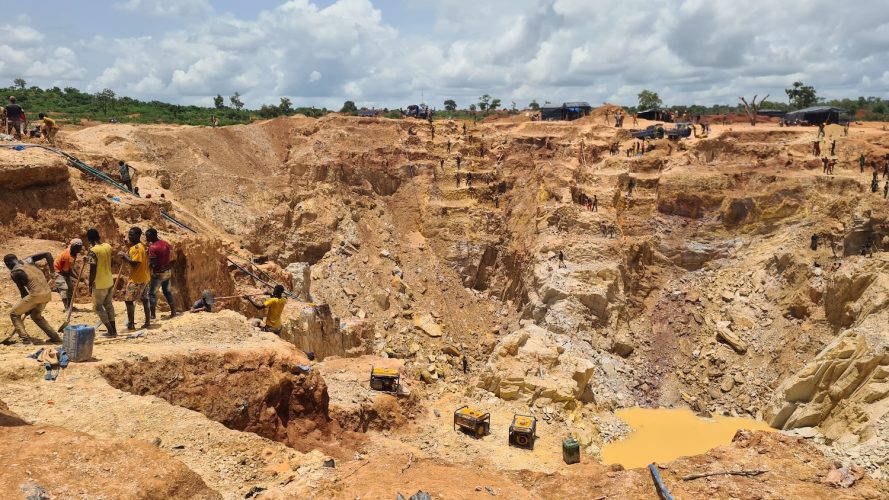TriplePundit • Is It Really a Just Transition If We Don’t Talk About Supporting Artisanal Miners?

This article is part of our series on responsible mining solutions. The push for clean energy is fueled by a growing demand for minerals, but conventional mining has a track record of harmful social and environmental impacts. Formalizing the artisanal and small-scale mining sector could be part of the solution to that problem.
In rural landscapes across Asia, Africa and Latin America, many make their living digging for valuable minerals by hand or with very basic machines. Gold is the most popular mineral for these miners, but due to the surge in demand for low-carbon technologies, artisanal and small-scale miners are increasingly joining the hunt for minerals like cobalt, copper and lithium.
By conservative estimates, close to 45 million people work in artisanal and small-scale mining around the world. Most of them do so informally, without any legal recognition of their work or formal labor protections.
The conditions that artisanal miners work in range from appalling and heartbreaking to more agreeable circumstances with some level of formalization. If done right, the push to formalize the sector could mean a more secure mineral supply chain, and access to workers’ rights, health and safety standards, and financial support for the miners.
“Formalization of the artisanal mining sector is an important step to ensuring artisanal miners enter the formal economy, work within a legal framework, and are supported to improve practices within their mine sites,” said Zuzia Danielski, communications director at Impact, a nonprofit that works in natural resource management where security and human rights are at risk.
Minerals from the margin to the mainstream
In the Democratic Republic of the Congo, where the majority of the world’s cobalt comes from, 15 to 30 percent of it (about 50,000 metric tons) is mined by artisanal and small-scale miners, according to the Intergovernmental Forum on Mining, Minerals, Metals and Sustainable Development.
Artisanal and small-scale mining employs up to 250,000 people in the country. Their average income is $3.28 per day, and 37 percent meet the criteria for forced labor, according to a University of Nottingham report.
Artisanal mining is mostly manual digging by individuals, while small-scale mining may have some level of mechanization and organization but is still largely informal. Both are on a much smaller scale than the massive mining operations run by national and international mining companies. For many families, artisanal mining has been their way of life for generations. More and more people are joining the industry as better options become scarcer.
“It’s sad to say that there are many rural and fragile areas where there are just very few viable alternatives,” said Jorden de Haan, senior technical manager of responsible mining at Pact, an NGO working with artisanal mining communities to improve worker conditions. “With climate change and extended droughts putting pressure on farming, agriculture, and livestock herding, that is all pushing people into artisanal and small-scale mining.”
Governments recognizing the work of artisanal and small-scale miners can bring much-needed protections and support.
Formalization only works if done right
Formalization could bring labor rights, health standards, and access to bank loans and other financial support to the sector, but many factors need to be considered.
“Formalization is often equated to legalization,” de Haan said. “The legal side is important, but the real issue is the compliance with those regulations. To enable compliance you need to help miners build their technical, administrative, and financial capacity and navigate the local politics of land access.”
Land access is often the biggest challenge when formalizing small-scale mining operations.
“The problem is that the vast majority of mineral-rich land is in the hands of industrial mining companies,” de Haan said. “This is a major challenge for small-scale miners because you cannot have your mining titles or mining license without having legal access to the land.”
To achieve this, governments need to set aside mineral-rich land for small-scale miners, instead of allowing large foreign companies to lay claim to it all, and balance foreign investment priorities with national development concerns. Similar to how deep-sea mining companies in international waters will likely be required to put one-half of the area they explore into a “reserve bank” to be used by developing countries, foreign companies exploring land reserves could reserve a percentage of the surveyed land for small-scale miners.
After the land access challenge, building the administrative, technical and financial capacity of miners is a top priority. That would help miners understand the support available to them and the new regulations they must comply with. Formalizing has to be accessible to artisanal and small-scale miners, or it may push them toward staying informal, or even becoming illegal if they do not conform to new regulations.
Still, two of the major barriers to formalization are the costs and the administrative process.
“In general, artisanal miners want to come into formal channels because, while yes, there is a cost associated with it, there’s also a certain level of support that comes with being formal,” said Jonathan Hamisi, senior policy advisor at the Intergovernmental Forum on Mining, Minerals, Metals and Sustainable Development. “However, if miners in remote locations have to travel 500 kilometers to the capital city, this makes it difficult for them. On top of that, you may have issues related to financial literacy or literacy in general.”
How can businesses support artisanal miners?
For businesses with supply chains that source minerals from artisanal and small-scale miners, there are some ways to help.
“Firstly, don’t shy away. Try to engage,” de Haan said. “I think an error that’s often made is that businesses only go one or two steps up the supply chain, and they don’t go further to the actual miners. It’s important they really do their due diligence at the local level.”
Many minerals have human rights risks associated with their production, but tools are available for businesses to conduct thorough supply chain due diligence to identify and mitigate human rights risks, like the Responsible Minerals Initiative’s due diligence toolkit.
“We need to shift the focus away from minerals and back to people,” Danielski said. “Only by investing in local development in artisanal mining communities, alongside sourcing initiatives, can we create responsible, equitable and sustainable supply chains.”
Hamisi echos that sentiment: “We can’t talk about a just transition if we don’t pay attention to the people who are producing the minerals.”



Post Comment